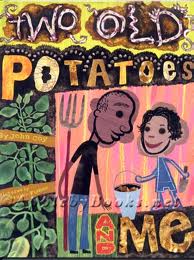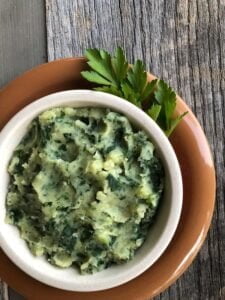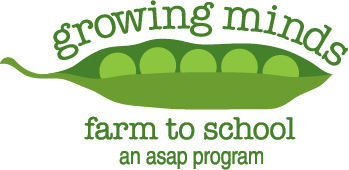This week’s theme is potatoes. Our “Growing Minds Day by Day” educational resource lists are designed for families and educators.
Growing Minds Day by Day
Potatoes
Potatoes are Growing Minds’ Get Local product for November. Because this versatile veggie is abundant at local farms this month, it’s a great time to highlight its nutritious qualities in your home or classroom. Potatoes are sometimes referred to as white potatoes or “Irish potatoes”, but they actually come in many shapes, sizes, and colors—including red, purple, and gold!
Potatoes were domesticated by indigenous peoples in South America between 7,000 and 10,000 years ago. Today, over 4,000 varieties of potatoes can still be found in Peru, primarily in the Andes mountains, but they’re also a staple food in many parts of the world. While regular potatoes are tubers (underground stems), sweet potatoes are roots. Sweet potatoes are a seasonal treat when they appear each fall. Like potatoes, they originated in the Americas.
Both potatoes and sweet potatoes can be mashed or roasted, or try them in soups or scrambles for a delicious dish. Fun fact: in October 1995, the potato became the first vegetable to be grown in space!
Books:
 Two Old Potatoes and Me
Two Old Potatoes and Me
In this book by John Coy, a girl discovers two old potatoes that have begun to sprout at the back of the cupboard. She goes to throw them away, but her dad suggests instead that they try to grow new potatoes from the old ones. The story details how they prepare the soil, care for the plants, and protect the plants from potato beetles. Their patience and hard work are rewarded with a brimming bucket of new potatoes. Watch a read aloud on YouTube. Recommended for ages 3-7. This book includes a recipe for mashed potatoes, which you can find below.
 Mr. Crum’s Potato Predicament
Mr. Crum’s Potato Predicament
When a fussy restaurant patron sends his order of potatoes back twice, chef George Crum decides to have some fun. This fictional picture book tale by author Anne Renaud is based on a real man named George Crum, a cook in Saratoga Springs, New York, in the 1850s, who is purported to have created the first potato chip in response to a demanding customer. Included at the back of the book is a historical note with a list of sources describing the legend and the remarkable and inspiring story of Crum, a trapper of mixed Native American and African American descent, who supplied restaurants with fresh game, then became a chef and successful restauranteur himself. This book is an excellent choice for lessons on inventions and inventors, history, or why we eat the foods we do.Watch a read aloud on YouTube. Recommended for grades preschool – 3.
Find more books
Both of the books above are available for Asheville-based educators to check out from our lending library. Visit the Growing Minds’ farm to school literature database to discover more of our favorite fall-themed children’s books. Type “potato” into the search bar to explore more of our favorite stories.
Local Food Recipe:
 Potatoes have a bad reputation because of their association with fried, unhealthy foods like French fries, but they are a great source of vitamins like vitamin C and potassium. Pairing potatoes with fresh greens like spinach, kale or collards can help you to create a healthy meal that kids will love.
Potatoes have a bad reputation because of their association with fried, unhealthy foods like French fries, but they are a great source of vitamins like vitamin C and potassium. Pairing potatoes with fresh greens like spinach, kale or collards can help you to create a healthy meal that kids will love.
Get kids involved in whipping up a batch of mashed potatoes–we’ve included two different versions below. Scrubbing, mashing, and stirring potatoes are great activities to help young children practice small muscle control in their fingers and hands. Older kids can assist with peeling and dicing the potatoes, and chopping the fresh herbs. Keep track of their culinary milestones using our Kids Cooking Bingo card.
Green Potatoes
Serves 4
Ingredients:
- 4 medium to large local potatoes
- 2 cups fresh spinach
- 2 Tbsp. butter
- 2-3 cloves garlic, minced (optional)
- Fresh herbs such as basil, rosemary, or dill, chopped (optional)
- Salt and pepper
Directions:
- Dice the potatoes and boil in a pot of water until soft.
- Steam the spinach, squeeze out excess water, and chop.
- Chop herbs.
- Mash potatoes until they are smooth (children love to help with this step!)
- Stir in the spinach, butter, herbs, and garlic. Add salt and pepper to taste.
Looking for a simpler recipe? Make the Mashed Potato recipe from the book Two Old Potatoes and Me by John Coy.
Educational Resources:
Growing Minds Lesson Plans & Resources
 Sweet Potato Exploration (preschool): Children use their sense to explore sweet potatoes and gain confidence in trying new vegetables. Students learn to identify a new vegetable. Students associate vegetables and fruits with a dynamic activity and positive experience.
Sweet Potato Exploration (preschool): Children use their sense to explore sweet potatoes and gain confidence in trying new vegetables. Students learn to identify a new vegetable. Students associate vegetables and fruits with a dynamic activity and positive experience.- Root and Shoots (preschool): Children learn how vegetables grow by will using their sense of sight and taste to determine the characteristics of vegetables that grow above and below ground. They become comfortable tasting new foods in the supportive, positive environment of their preschool.
- Potato Exploration (K-2): Introduce students to potatoes and how they grow. Teach students about measurement and guide them practicing close observation through potato explorations.
- Soil Exploration (K-2): Through garden exploration, students will learn about the properties of soil and why soil is important to plants. They will closely observe soil and practice tallying and reporting results of soil experiments.
- Sweet Potato Fritters: This lesson plan has step by step instructions for cooking in the classroom and features literature and curriculum connections.
- Thanksgiving for Farmers (K-2): Review activities that happen on the farm and animals that live there. Make the connection between farms and the food we eat each day, emphasizing the importance of community farms. Introduce letter writing, specifically thank you letters, and guide students in writing thank you letters to farmers in your county or region.
- More November resources: Find additional potato recipes, books, and “This week in the Garden” activity sheets.
- Video: Farm to School Taste Test: Education and nutrition teachers can use this video as a training tool for cafeteria taste tests. In this how-to video, students at Cullowhee Valley Elementary School enjoy a taste test of local sweet potatoes with help from Western Carolina University pre-service teachers and dietitians.
Activities:
 Potato Observation: Have students compare and contrast two different varieties of potatoes, such as red and fingerling. Record the differences and similarities in a VENN diagram. Make sure that students get a chance to compare flavor, too!
Potato Observation: Have students compare and contrast two different varieties of potatoes, such as red and fingerling. Record the differences and similarities in a VENN diagram. Make sure that students get a chance to compare flavor, too! - How many “potatoes” tall are you? Have students make paper potatoes (using grocery store paper bags). Use the paper potatoes to create a height chart for the class. This is a great nonstandard measurement activity!
- Creative Writing: Challenge students to write creative stories detailing how the potato chip might have been invented, then use references to research the real story.
- Potato Stamps: Cut several potatoes in half. On the flat sides, draw and then carve simple patterns or designs into the potatoes. Put out a tray of washable paints, then let your children dip the potatoes into the paint to make prints with them on paper. If there’s too much paint on the potato, the stamp will slip. Show the children how to carefully dab excess paint onto a scrap piece of paper before they print.
- Grow a Sweet Potato: You and your child can easily grow your own sweet potato plant at home. To do so, cut a sweet potato in half and stick three or four toothpicks into the potato about halfway up. Place the potato in a small jar or glass so that the toothpicks rest on the container’s rim. Fill the glass with enough water so that it covers the bottom half of your sweet potato. Put it on a sunny windowsill and change the water every couple of days. It may take a few weeks or even a month before you see sprouts, but once they start, the vines and roots will grow quickly. After your potato has sprouted, you can continue to let it grow in water or transplant it in a pot as a houseplant. Once the plants get bigger, you can eat the leaves and shoots when they are tender and young. They have a mild, yet slightly spicy flavor.
Do the Mashed Potato:
Get your family or class moving! The Mashed Potato was a dance craze in the early 1960s. Watch a video of R&B singer Dee Dee Sharp performing “Mashed Potato Time”, then use the instructions below from Wikipedia to learn the mashed potato moves. A variation on the mashed potato was also danced to the novelty hit song “The Monster Mash” by Bobby Picket. Watch a Kidz Bop Monster Mash dance video to celebrate Halloween!
The dance move begins by stepping backward with one foot with that heel tilted inward. The foot is positioned slightly behind the other (stationary) foot. With the weight on the ball of the starting foot, the heel is then swiveled outward. The same process is repeated with the other foot: step back and behind with heel inward, pivot heel out, and so on. The pattern is continued for as many repetitions as desired. The step may be incorporated in various dances either as a separate routine or as a styling of standard steps.
—
That’s it for this week. Check back next week for new resources. Click here to access Day by Day resources from past weeks. If you didn’t find what you’re looking for here, please visit our Lesson Plans page.


 Sweet Potato Exploration
Sweet Potato Exploration Potato Observation:
Potato Observation: